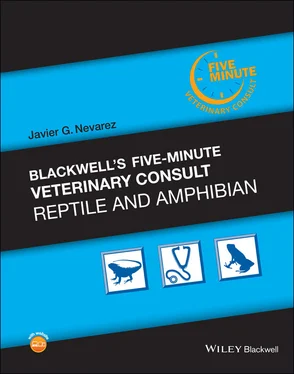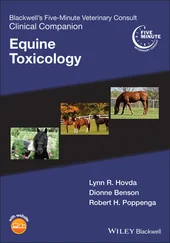Javier G. Nevarez - Blackwell's Five-Minute Veterinary Consult - Reptile and Amphibian
Здесь есть возможность читать онлайн «Javier G. Nevarez - Blackwell's Five-Minute Veterinary Consult - Reptile and Amphibian» — ознакомительный отрывок электронной книги совершенно бесплатно, а после прочтения отрывка купить полную версию. В некоторых случаях можно слушать аудио, скачать через торрент в формате fb2 и присутствует краткое содержание. Жанр: unrecognised, на английском языке. Описание произведения, (предисловие) а так же отзывы посетителей доступны на портале библиотеки ЛибКат.
- Название:Blackwell's Five-Minute Veterinary Consult: Reptile and Amphibian
- Автор:
- Жанр:
- Год:неизвестен
- ISBN:нет данных
- Рейтинг книги:4 / 5. Голосов: 1
-
Избранное:Добавить в избранное
- Отзывы:
-
Ваша оценка:
- 80
- 1
- 2
- 3
- 4
- 5
Blackwell's Five-Minute Veterinary Consult: Reptile and Amphibian: краткое содержание, описание и аннотация
Предлагаем к чтению аннотацию, описание, краткое содержание или предисловие (зависит от того, что написал сам автор книги «Blackwell's Five-Minute Veterinary Consult: Reptile and Amphibian»). Если вы не нашли необходимую информацию о книге — напишите в комментариях, мы постараемся отыскать её.
STAY UP TO DATE ON THE BEST PRACTICES FOR TREATING COMMON DISEASES IN REPTILES AND AMPHIBIANS Blackwell’s Five-Minute Veterinary Consult: Reptile and Amphibian
Blackwell’s Five-Minute Veterinary Consult: Reptile and Amphibian
Blackwell's Five-Minute Veterinary Consult: Reptile and Amphibian — читать онлайн ознакомительный отрывок
Ниже представлен текст книги, разбитый по страницам. Система сохранения места последней прочитанной страницы, позволяет с удобством читать онлайн бесплатно книгу «Blackwell's Five-Minute Veterinary Consult: Reptile and Amphibian», без необходимости каждый раз заново искать на чём Вы остановились. Поставьте закладку, и сможете в любой момент перейти на страницу, на которой закончили чтение.
Интервал:
Закладка:
Javier G. Nevarez
Acknowledgments
I have been fortunate in my professional career to have mentors and individuals support my goals and ambitions. Specifically, I would like to thank Drs. Thomas Tully and Mark Mitchell, two of the best mentors anyone could have, for their unwavering support and dedication. To the LSU zoological medicine team: Jordan Padlo, interns, residents, and veterinary students, thank you for keeping me honest and serving as an inspiration to stay current on the most up to date literature. I would also like to thank all the authors who answered the call and agreed to contribute to this book. It was truly overwhelming to see your positive responses and willingness to work on this project.
About the Companion Website
The book is accompanied by a website:
www.wiley.com/go/nevarez/reptileamphibian 
The website includes the contents listed below:
REPTILES
HISTORY
History form
PHYSICAL EXAM
Chelonian physical exam form
Crocodilian physical exam form
Lizard physical exam form
Snake physical exam form
SEXING
Figures 1–6
VENIPUNCTURE SITES
Figures 1–23
AMPHIBIANS
HISTORY
History form
PHYSICAL EXAM
Anuran physical exam form
Salamander physical exam
VENIPUNCTURE SITES
Figures 1 and 2
SUPPLEMENTARY CONTENT FOR MAIN TEXT
SECTION I
Reptile Anatomy and Physiology
UVB Lighting Principles for Captive Reptiles
Anatomy and Physiology of Amphibians
UVB Lighting Principles for Captive Amphibians
Equipment and Medications Useful for Treating Reptile Patients
Figures 1 and 2
SECTION II: CHELONIANS
Figures 1–12
SECTION III: LIZARDS
Figures 1–6
SECTION IV: SNAKES
Figure 1
SECTION V: CROCODILIANS
Figures 1 and 2
Introduction to Reptile Medicine
Captive reptiles can be found in zoological institutions, the pet trade, commercial farming, universities, and laboratory animal facilities. Along with the prevalence of captive reptiles, there is a higher demand for improved welfare and veterinary care. As veterinarians, it is our duty not only to provide high‐quality medicine but also to serve as a source of reliable information and education for reptile owners and keepers. Veterinary care of reptiles must include education on proper husbandry and nutrition, two critical factors that influence the health of reptile patients. To be successful in this endeavor, we must understand the reptile market and the demographics of reptile owners and keepers. According to a 2019–2020 report by the American Pet Products Association, reptiles comprise approximately 4.5% of the pets owned by households in the United States. The Federation of British Herpetologists claims that the number of pet reptiles in the United Kingdom may surpass that of dogs and cats, but it is difficult to find supporting data for these claims across European countries. Nonetheless, it is well known that the reptile trade is strong and thriving in Europe as well as in the United States. Of interest is the age distribution of reptile owners in the United States. Fifty‐three percent of reptile owners are in the “gen Y” (1994–1980) generation followed by 26% “gen X” (1979–1965), 19% “baby boomers” (1964–1946) and 2% “builders” (1945–1920).
Not surprisingly, the majority of reptile owners rely on the internet to obtain information about reptile care. The second most common source of information is pet store employees, while only 21% rely on veterinarians. This should be a clear indication that veterinarians need to be more proactive in reaching out a to the reptile‐owning generations in ways that they can relate to so they can build up clientele and improve the welfare of captive reptiles. This requires a paradigm shift in which veterinarians seek out promoting and advertising opportunities to make the public aware of their services. Many reptile‐owning individuals are not even aware of all the veterinary services available for reptile species. If these individuals were more aware and developed a relationship with veterinarians, we would be more likely to have a positive impact on the captive care and welfare of reptiles. While there may be varying degrees of the bond that humans form with reptiles, most reptile owners are very appreciative of veterinarians willing and able to care for their pets. Veterinarians should offer the same standard of care to reptiles as they do to other species and charge accordingly for their time and services.
With over 10,000 species of reptiles, it is impossible to know the proper care for all species. Instead, the focus should be placed on becoming knowledgeable about the more common species that one will be working with in the course of practice. The commonality of species may vary with geographical location; nonetheless, some species such as bearded dragons, ball pythons, and sulcata tortoises are overrepresented in the pet trade.
The first approach to learning about reptiles is to think in terms of their biology. Reptiles are not domesticated species and still retain many of the behaviors observed in their natural environment. Being familiar with their natural history and biology will facilitate their captive care and treatment. In order to understand reptiles, one must be able to correctly identify the species and be familiar with their country of origin, climate, habitat, dietary scheme, photoperiod, and natural behaviors. Field guides and books have an abundance of information to help identify species and their environment.
Knowing the country and climate in which reptiles live will help to differentiate tropical from temperate and desert species. This information will directly influence their temperature requirements and photoperiod. Tropical and desert species will require higher environmental temperatures and will have longer photoperiods as compared with temperate species. Their habitat can also be divided into arboreal, aquatic, terrestrial, and fossorial (live underneath leaves and shallow layer of soil). Many species cross between habitats but will have a preference for one and feel most comfortable in it. For example, green iguanas are an arboreal species but spend time on the ground searching for food and during the breeding season. When they are done foraging and at the end of the day, they roost in trees where they feel more comfortable high off the ground away from predators.
An important consideration is the natural patterns of activity according to photoperiod. Diurnal species are active during the day and should be fed during the day to allow ample time to ingest food. Nocturnal species should be fed at dusk, dawn, or during the night, when they are more active and likely to be on the search for food. Knowing their dietary scheme is another important aspect of reptile biology. Reptiles can be omnivores, herbivores, insectivores, or carnivores. Providing high quality nutrition according to their dietary scheme is essential for good health and a primary challenge in captivity. Omnivores should be fed high‐quality commercial diets in combination with fresh produce. Carnivores should be fed whole, pre‐killed prey items of appropriate size. Herbivores should be fed a variety of fresh produce, grasses, and hays, in addition to a high‐quality commercial diet. Insectivores should be fed a high‐quality commercial diet in addition to a variety of invertebrates. In Europe, there is a wider variety of commercially available invertebrates compared to the United States. In order to offer a wide variety of invertebrates in the United States, owners are primarily restricted to purchasing through online retailers.
Читать дальшеИнтервал:
Закладка:
Похожие книги на «Blackwell's Five-Minute Veterinary Consult: Reptile and Amphibian»
Представляем Вашему вниманию похожие книги на «Blackwell's Five-Minute Veterinary Consult: Reptile and Amphibian» списком для выбора. Мы отобрали схожую по названию и смыслу литературу в надежде предоставить читателям больше вариантов отыскать новые, интересные, ещё непрочитанные произведения.
Обсуждение, отзывы о книге «Blackwell's Five-Minute Veterinary Consult: Reptile and Amphibian» и просто собственные мнения читателей. Оставьте ваши комментарии, напишите, что Вы думаете о произведении, его смысле или главных героях. Укажите что конкретно понравилось, а что нет, и почему Вы так считаете.












